Last Updated: 04/06/2025
Staffy Breed Guide | Behaviour & Nutrition
The humble Staffordshire Bull Terrier is one of Australia's favourite dog breeds. Learn why here!
Author: Dr Teagan Lever BVSc (Hons)
Reading Time: 30 minutes - long read
Don't be fooled by their tough exteriors, these muscly little livewires are more likely to lick you all over than do you any harm. The humble Staffordshire Bull Terrier (or Staffy) is one of Australia's favourite dog breeds, and as the owner of two Staffies myself I may be more than a little bit biased when I say this is for good reason!
All about Staffordshire Bull Terriers
Place of origin
England
Weight range
10.9-17.2kg
Breed size
Medium
Height range
35-41cm
Breed group
Terriers
Life expectancy
12-14 years
Coat colours
Various
Grooming needs
Low
Coat type
Short, smooth
Health issues
Allergic skin disease, anxiety
Shedding factor
Moderate
Exercise needs
Moderate
Play style
Chew, tug, fetch
Housing needs
Not suited to apartments
Trainability
Moderate
Social needs
High
Family suitability
Great for most families
Tendency to bark
Moderate
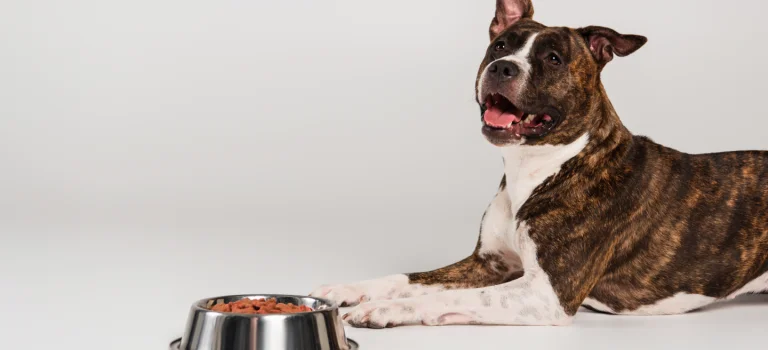
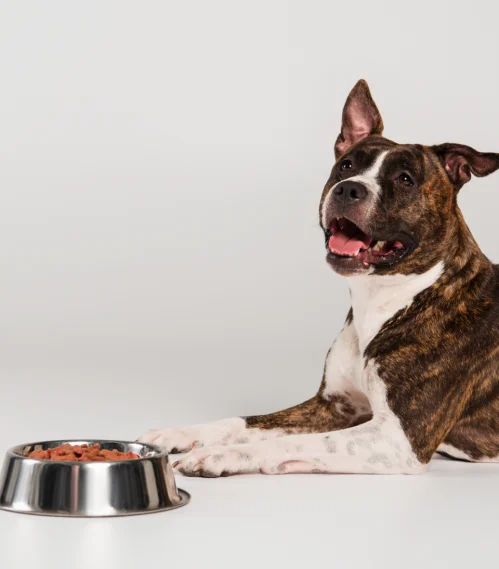
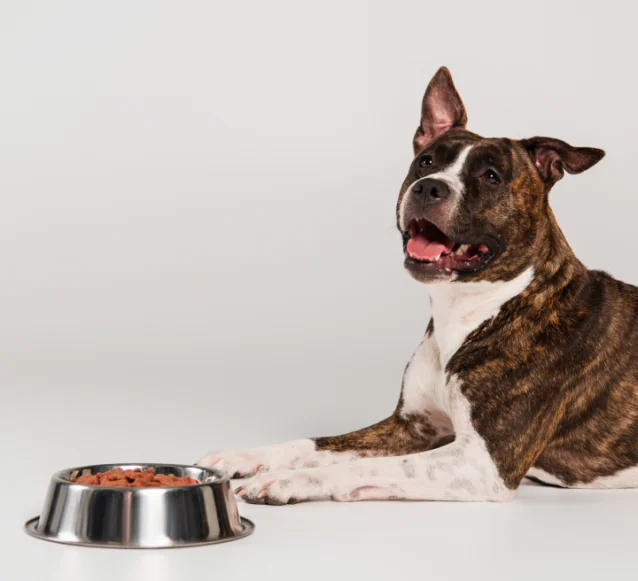
Nutrition
The right diet can make a big difference on your dog's health and wellbeing. As Staffies are a medium sized breed, a medium or all breed formula will usually be the best option. Although they have no highly specific nutrient requirements compared with other medium sized breeds, there are a few key attributes to look for when choosing food for your Staffy.
Best food for adult Staffies
As a breed predisposed to skin sensitivities, it can be beneficial to choose a food that has a higher content of omega fatty acids to support a healthy skin barrier and reduce inflammation, redness and itching. Many premium science brands are enriched with fish oil for this reason, although fish based diets in general can also be a good choice.
Diets that are highly digestible and designed to support a healthy gut microbiome with ingredients such as prebiotics and postbiotics are also well suited to Staffies, who can suffer from sensitive stomachs.
Staffies can also be quite an active breed, which can see them begin developing joint issues and arthritis over time. Feeding a diet with additional beneficial nutrients to support joint health, such as green lipped mussel, glucosamine and chondroitin may help to maintain better mobility as they age.
What to look for
Higher levels of omega 3 and 6 fatty acids plus additional nutrients to support skin health such as Zinc, pantothenic acid and niacin
Highly digestible, added prebiotics and probiotics for healthy digestion and good stool quality
Joint health support nutrients such as green lipped mussel, glucosamine and chondroitin
Vet picks
Best food for Staffy puppies
Puppies have sensitive tummies, so a highly digestible formula is key to avoid digestive upsets. Look for added prebiotic fibers like chicory root, fruit, vegetable fibers, whole grains, and seeds to nurture a healthy gut microbiome. Colostrum provides additional digestive support, while omega-3 DHA and choline promote brain and cognitive development in your Staffy puppy.
Where possible, choose a medium breed puppy formula to ensure the optimal balance of energy, protein, vitamins and minerals to support healthy growth. Breed size tailored formulas often also have customised kibble sizes and textures to make them easier for puppies to pick up and chew.
What to look for
Complete and balanced medium breed puppy formulas
Highly digestible formula to help prevent tummy upsets
DHA for healthy brain and eye development
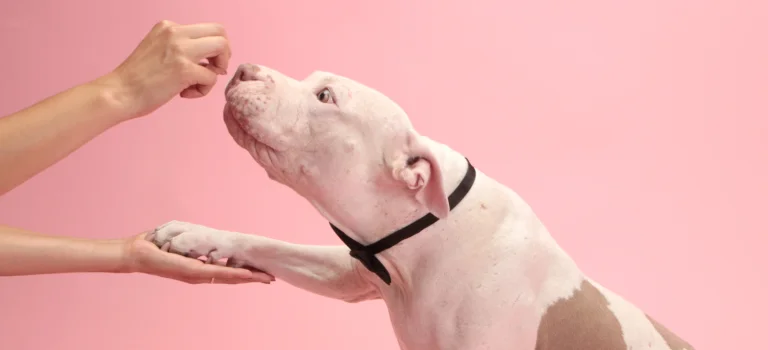
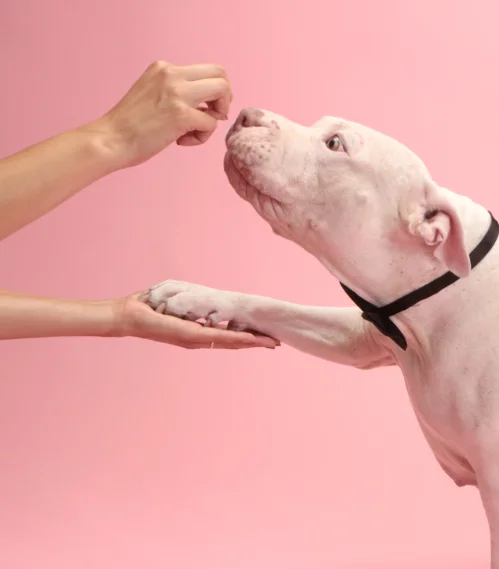
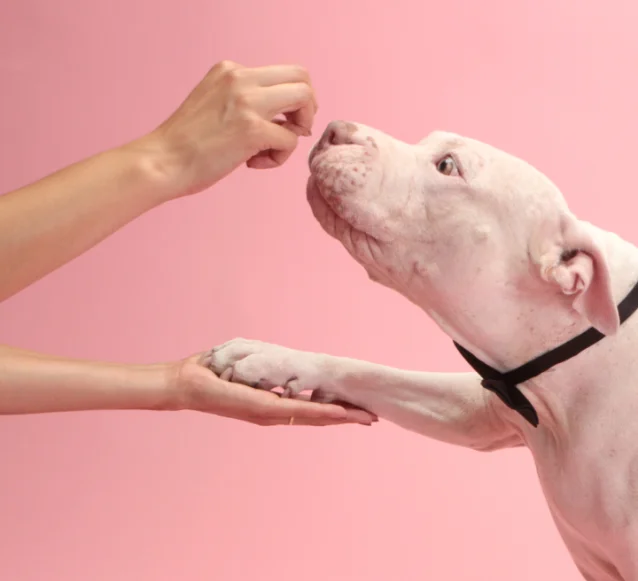
Flea & worming
Keeping your Staffy protected year round against common parasites is essential to maintaining their health. This should include coverage against fleas, ticks, heartworm and intestinal worms.
Best flea and worming treatments for Staffies
Staffies can have sensitive skin which makes it extra important to be vigilant about year round flea control. Depending on where you live, you may also need to pair this with protection against paralysis ticks. To keep things simple, you could opt for an all in one monthly chewable or tablet, or choose to use an annual heartworm injection supplemented by monthly worming and oral flea and tick treatments.
What to look for
Effective year round flea and tick control
All in one products for simplicity
Always double check the weight range to ensure an effective dose
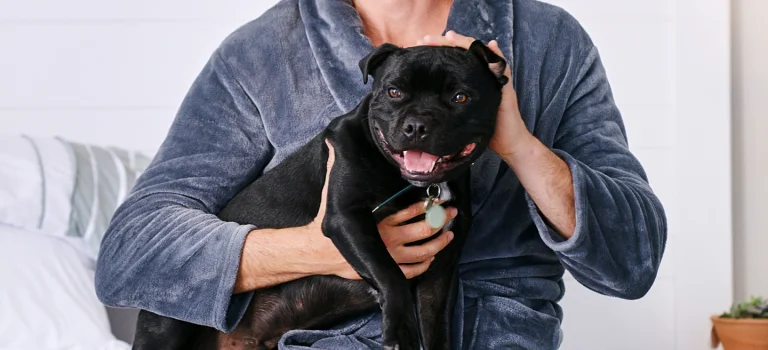
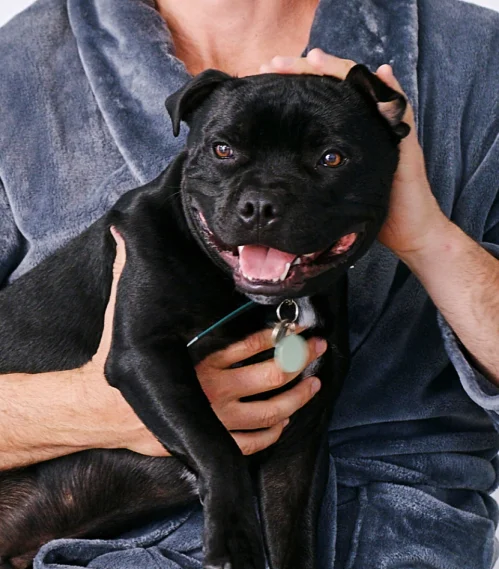
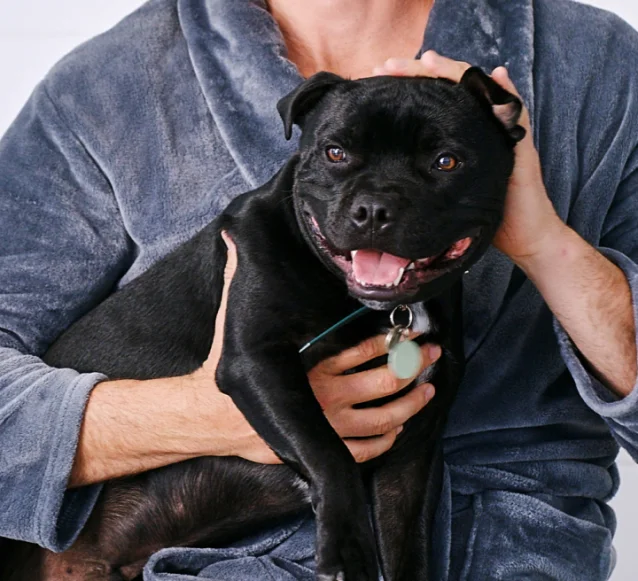
Health
For Staffies with sensitive skin, it's crucial to work with your vet to determine the underlying cause. Typically allergic skin disease is the major cause of itching and redness.
Your vet may recommend a number of diagnostic tests including skin tape impressions and scrapings, as well as an elimination diet trial to rule out food allergies using a hypoallergenic vet diet.
Best products for Staffies with sensitive skin
Increasing your Staffy's intake of omega fatty acids, particularly EPA and DHA from marine sources, can help to reduce itching and redness, while also supporting a healthy skin barrier. Hypoallergenic diets may be recommended by your veterinarian if they suspect food allergies, these can be based on a hydrolysed protein or novel protein source.
Topical treatments can also be helpful, these can include oils, creams and shampoos to soothe irritated skin and remove allergens, as well as antibacterial and antifungal washes and creams to treat secondary infections. Dogs with skin allergies often have concurrent ear infections, so it is wise to use an ear cleaner regularly to keep bacteria and yeast under control
What to look for
Supplements rich in omega fatty acids, particularly EPA and DHA
Soothing topical washes and treatments
Hydrolysed or novel protein diets for dogs with food allergies
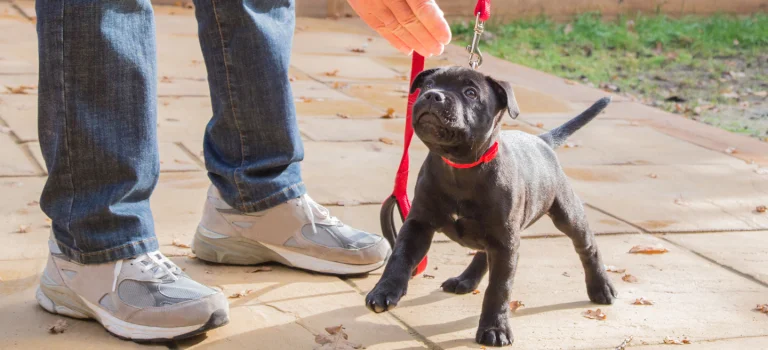
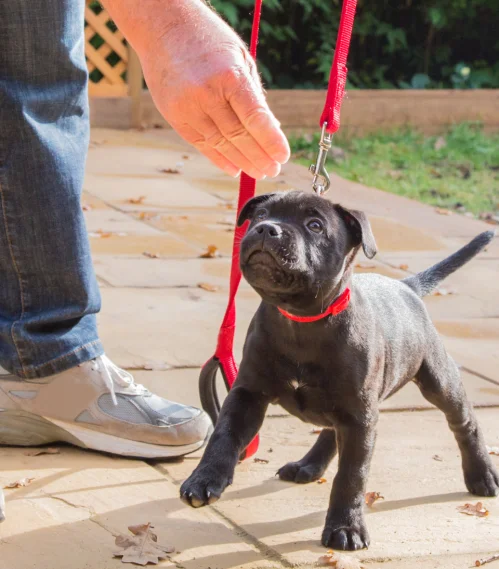
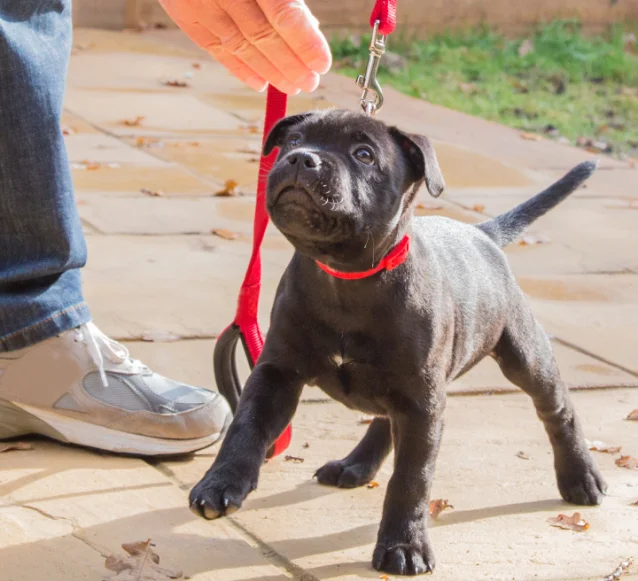
Training and activity
Keeping your Staffy physically and mentally fit requires a multi-modal approach including exercise, play, social interaction and mental stimulation. If their needs are not addressed, Staffies can become bored or anxious and display problematic behaviours such as digging, destructive chewing and escaping.
Best toys for Staffies
There are not many breeds that can destroy toys as quickly and effectively as the Staffy. Their natural inclination towards chewing and powerful bite force mean that finding toys durable enough to last can be a major challenge. Those made from the most durable rubber, hard nylon and thick rope tend to be the best options.
Food dispensing toys are a useful tool in preventing boredom and tackling separation anxiety when your Staffy is spending time alone.
What to look for
Tug and fetch toys constructed from very tough rubber or thick rope
Food dispensing toys and puzzles to slow down mealtime and reduce boredom
Highly durable chew toys made hard nylon or very tough rubber
Best anxiety solutions for Staffies
As a breed predisposed to anxiety, many Staffies can benefit from the use of calming accessories, diets and health products. While no one product is going to completely cure a dog of anxiety, they can be helpful when combined with training techniques and other strategies. If you suspect your dog is anxious, it's always a good idea to consult your veterinarian prior to beginning a new treatment.
What to look for
Supplements and diets containing ingredients proven to help manage anxiety in dogs
Synthetic pheremones such as Adaptil to reduce anxiety
Calming wraps and vests that work in the same way as swaddling an infant
Best walking accessories for Staffies
When walking your Staffy, it's crucial to use appropriate equipment to ensure both their safety and the safety of others. Use no pull harnesses or headcollars if your Staffy tends to pull. For extra control, a dual attaching lead is also a great option.
Reactive dogs can benefit from wearing colour-coded and labelled accessories. This simple measure alerts other dog owners and passersby that your dog may need extra space, helping to prevent unwanted interactions and potential conflicts.
What to look for
No pull harnesses or headcollars to prevent pulling or lunging forward
For reactive dogs, colour coded and labelled accessories to let others know to give space
Dual attachment harnesses and shorter leads for extra control
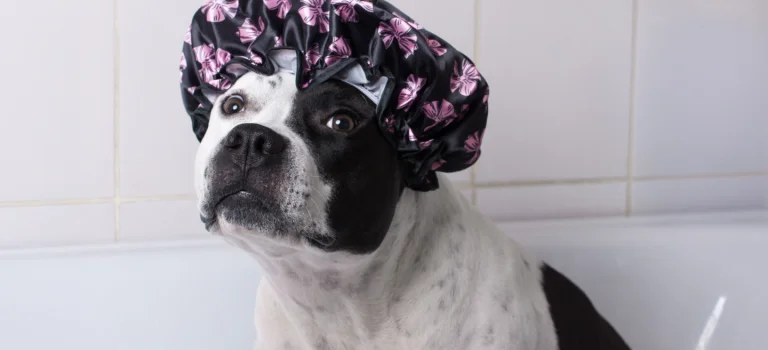


Grooming
Due to their short, smooth coat Staffies are a low maintenance breed when it comes to grooming. Typically a bath every two to four weeks and a weekly brush to remove loose hair from the coat is sufficient.
Best grooming products for Staffies
Due to their propensity to skin allergies, it's best to use gentle shampoos and conditioners designed for sensitive skin that contain ingredients that moisturise and soothe. It's also a good idea to use a gentle, drying ear cleaner after bathing or swimming to prevent build up of moisture in the ears which can trigger yeast and bacterial growth. For a short haired breed, Staffies do shed more than you might expect, so brushing every week or so with a bristle brush or rubber curry comb can help reduce the hair that falls around your home.
What to look for
Gentle ear cleaners to for use after bathing and swimming
A bristle brush or rubber curry comb to remove loose hair
Shampoos and conditioners designed for sensitive skin
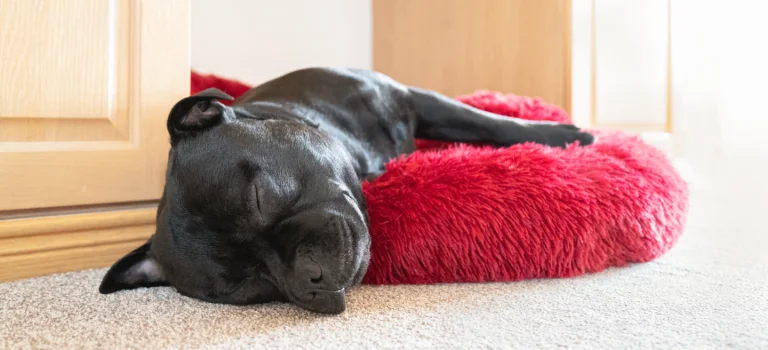
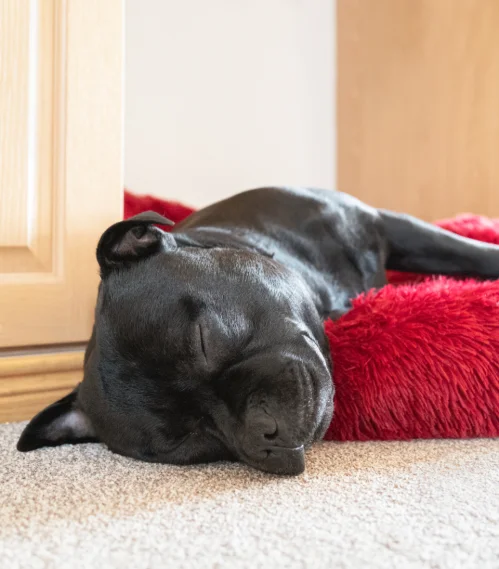
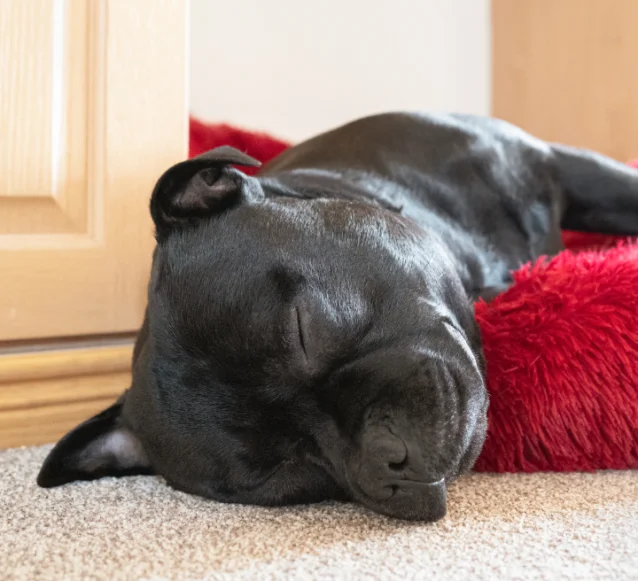
Sleep and home
Staffies tend to play hard and fast for short periods with long stretches of sleep in between. While every dog is different, most adult Staffies sleep for around 12 to 14 hours per day. Even if your Staffy shares your bed at night time, it's important that they also have their own place to nap independently of you during the day.
Best beds for Staffies
The best bed ultimately depends on your Staffy's size and sleeping style, on average most Staffies will need a bed that is at least 90cm long and 60cm wide to be able to lie down comfortably. Mattress or bolster beds with covers made from durable fabrics like nylon will help the bed to stand the test of time, but for extreme chewers you may need to consider a stuffing free elevated 'hammock' style bed instead.
What to look for
Stuffing free alternatives like elevated hammock style beds for extreme chewers
Durable covers that can be washed and replaced as needed
Medium to large size depending on your dog's measurements

